At 70, you are still a child.
At 80, a young man or woman.
If at 90, someone from Heaven invites you over, tell him,
“Just go away, and come back when I am 100.”
~ Saying carved into a rock facing the sea near the village of Kijioka, in Okinawa, Japan (featured in Superhuman: Life at the Extremes of Our Capacity)
The ’80s pop band Level 42 took their name from the brilliantly imaginative sci-fi novel, The Hitchhiker’s Guide to the Galaxy, in which the people of Earth ask a computer named Deep Thought for the answer to “Life, the Universe, and Everything.” Seven million years later, Deep Thought delivers its momentous conclusion to their descendants: 42. The year I turned 42, I conceived of this age as the ultimate anti-aging tonic.
 Now, a Twitter friend has gone one better with this creative suggestion: “We should start referring to ‘age’ as ‘levels’. So when you’re level 80 it sounds more badass than just being an old person.”
Now, a Twitter friend has gone one better with this creative suggestion: “We should start referring to ‘age’ as ‘levels’. So when you’re level 80 it sounds more badass than just being an old person.”
An intriguing idea. No doubt LOs will be able to infuse their HECM presentations with this terminology as well, helping to reposition aging as a state of growth. Informing a prospect, “Now that you’ve reached Level 62 (or 75, or 83), there is a new opportunity open to you,” sounds inspiring indeed.
Traveling Back Through Time
Upleveling aging extends beyond mere verbiage, however. As we’ve explored before, telomeres (the tiny “shoelace caps” on our DNA that shorten with age) determine how quickly we grow old. With the 2009 game-changing discovery of the enzyme telomerase, which slows, stops and can even reverse telomere shortening, we may be on track to immortality. (Planetary carrying capacity is a subject for another day…).
We can learn a lot about how to help keep our telomeres healthy through diet, exercise and mindset. But beyond this, science has now discovered how to end cellular senescence, i.e., the aging that takes place within our cells.
A naturally-occurring “molecular postcode” delivered directly into the cells, experimental at present, may eventually be able to remove senescent cells in humans, allowing medicine to target multiple age-related diseases at once.
Watch This…
In the meantime, technology continues to improve life for those already facing chronic health conditions. One exciting development is the anti-Parkinson’s watch, which could help the more than ten million people living with Parkinson’s disease worldwide.
One hallmark of this degenerative brain disorder is hand tremors. When Emma Lawton, a UK-based graphic designer, was diagnosed with early-onset Parkinson’s at just 29, Microsoft innovation director Haiyan Zhang was inspired to invent a device to enable Lawton and others like her to write and draw legibly again.
The result is the Emma Watch, which uses vibrating motors to distract the wearer’s brain from trying to control the body’s limbs. It’s a creative disruption in autonomic functioning akin to the fantasy flights described in The Hitchhiker’s Guide to the Galaxy — except now we’re making these creative leaps reality.
How to Avoid Inflammaging
Of course, one of the best courses of action for a HECM prospect or client who wants to uplevel aging is to avoid inflammaging (inflame-aging). Inflammation is at the core of all disease states.
It’s helpful to know — and eat — foods that fight inflammation. Most of them are delicious, even a treat: red wine and dark chocolate make the list, along with walnuts, wild-caught salmon, extra-virgin olive oil and broccoli.
Our telomeres may indeed have a rosy future, even if we never leave this galaxy.





 Just two days after deciding not to pursue further medical treatment, Mrs. Bush passed away, surrounded by her loved ones. The same might have been true for my mom; instead, she endured seven weeks of machine-supported existence, dying in the sterile, institutional healthcare environment so pervasive in modern America.
Just two days after deciding not to pursue further medical treatment, Mrs. Bush passed away, surrounded by her loved ones. The same might have been true for my mom; instead, she endured seven weeks of machine-supported existence, dying in the sterile, institutional healthcare environment so pervasive in modern America.